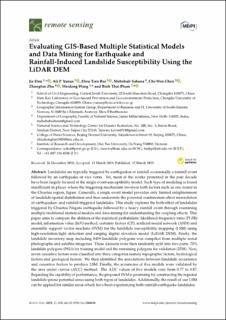| dc.contributor.author | Dou, Jie | |
| dc.contributor.author | Yunus, Ali P. | |
| dc.contributor.author | Tien Bui, Dieu | |
| dc.contributor.author | Sahana, Mehebub | |
| dc.contributor.author | Chen, Chi-Wen | |
| dc.contributor.author | Zhu, Zhongfan | |
| dc.contributor.author | Wang, Weidong | |
| dc.contributor.author | Pham, Binh Thai | |
| dc.date.accessioned | 2020-03-12T10:47:39Z | |
| dc.date.available | 2020-03-12T10:47:39Z | |
| dc.date.created | 2019-03-16T11:43:05Z | |
| dc.date.issued | 2019 | |
| dc.identifier.citation | Remote Sensing. 2019, 11 (6). | en_US |
| dc.identifier.issn | 2072-4292 | |
| dc.identifier.uri | https://hdl.handle.net/11250/2646528 | |
| dc.description | This article is an open access article distributed under the terms and conditions of the Creative Commons Attribution
(CC BY) license | en_US |
| dc.description.abstract | Landslides are typically triggered by earthquakes or rainfall occasionally a rainfall event followed by an earthquake or vice versa. Yet, most of the works presented in the past decade have been largely focused at the single event-susceptibility model. Such type of modeling is found insufficient in places where the triggering mechanism involves both factors such as one found in the Chuetsu region, Japan. Generally, a single event model provides only limited enlightenment of landslide spatial distribution and thus understate the potential combination-effect interrelation of earthquakes- and rainfall-triggered landslides. This study explores the both-effect of landslides triggered by Chuetsu-Niigata earthquake followed by a heavy rainfall event through examining multiple traditional statistical models and data mining for understanding the coupling effects. This paper aims to compare the abilities of the statistical probabilistic likelihood-frequency ratio (PLFR) model, information value (InV) method, certainty factors (CF), artificial neural network (ANN) and ensemble support vector machine (SVM) for the landslide susceptibility mapping (LSM) using high-resolution-light detection and ranging digital elevation model (LiDAR DEM). Firstly, the landslide inventory map including 8459 landslide polygons was compiled from multiple aerial photographs and satellite imageries. These datasets were then randomly split into two parts: 70% landslide polygons (5921) for training model and the remaining polygons for validation (2538). Next, seven causative factors were classified into three categories namely topographic factors, hydrological factors and geological factors. We then identified the associations between landslide occurrence and causative factors to produce LSM. Finally, the accuracies of five models were validated by the area under curves (AUC) method. The AUC values of five models vary from 0.77 to 0.87. Regarding the capability of performance, the proposed SVM is promising for constructing the regional landslide-prone potential areas using both types of landslides. Additionally, the result of our LSM can be applied for similar areas which have been experiencing both rainfall-earthquake landslides | en_US |
| dc.language.iso | eng | en_US |
| dc.relation.uri | https://www.mdpi.com/2072-4292/11/6/638 | |
| dc.rights | Navngivelse 4.0 Internasjonal | * |
| dc.rights.uri | http://creativecommons.org/licenses/by/4.0/deed.no | * |
| dc.title | Evaluating GIS-Based Multiple Statistical Models and Data Mining for Earthquake and Rainfall-Induced Landslide Susceptibility Using the LiDAR DEM | en_US |
| dc.type | Peer reviewed | en_US |
| dc.type | Journal article | en_US |
| dc.description.version | publishedVersion | en_US |
| dc.rights.holder | © 2019 by the authors. Licensee MDPI, Basel, Switzerland. | en_US |
| dc.source.pagenumber | 30 | en_US |
| dc.source.volume | 11 | en_US |
| dc.source.journal | Remote Sensing | en_US |
| dc.source.issue | 6 | en_US |
| dc.identifier.doi | 10.3390/rs11060638 | |
| dc.identifier.cristin | 1685297 | |
| cristin.ispublished | true | |
| cristin.fulltext | original | |
| cristin.qualitycode | 1 | |

